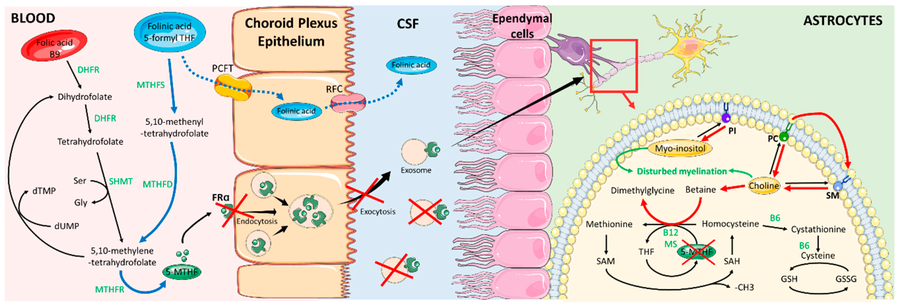Cerebral Folate Deficiency

Cerebral folate deficiency is a condition in which concentrations of 5-methyltetrahydrofolate are low in the brain as measured in the cerebral spinal fluid despite being normal in the blood. Symptoms typically appear at about 5 to 24 months of age. Without treatment there may be poor muscle tone, trouble with coordination, trouble talking, and seizures.
One cause of cerebral folate deficiency is a mutation in a gene responsible for folate transport, specifically FOLR1. This is inherited from a person's parents in an autosomal recessive manner. Other causes appear to be Kearns–Sayre syndrome and autoantibodies to the folate receptor.
For people with the FOLR1 mutation, even when the systemic deficiency is corrected by folate, the cerebral deficiency remains and must be treated with folinic acid. Success depends on early initiation of treatment and treatment for a long period of time. Fewer than 20 people with the FOLR1 defect have been described in the medical literature.
Signs and symptoms

Children with the FOLR1 mutation are born healthy. Symptoms typically appear at about 5 to 24 months of age. The symptoms get worse with time. Without treatment there may be poor muscle tone, trouble with coordination, trouble talking, and seizures.
Causes
One cause of cerebral folate deficiency is due to a genetic mutation in the FOLR1 gene. It is inherited from a person's parents in an autosomal recessive manner. Other causes appear to be Kearns–Sayre syndrome and autoantibodies to the folate receptor.
Furthermore, secondary cerebral folate deficiency can develop in patients suffering from other conditions. For example, it can develop in AADC deficiency through the depletion of methyl donors, such as SAM and 5-MTHF, by O-methylation of the excessive amounts of L-dopa present in patients.
Treatment
For people with the FOLR1 mutation, even when the systemic deficiency is corrected by folate, the cerebral deficiency remains, and must be treated with folinic acid. Success depends on early initiation of treatment. Treatment requires taking folinic acid for a significant period of time. Fewer than 20 people with the FOLR1 defect have been described in the medical literature. Treatment with pharmacologic doses of folinic acid has also led to reversal of some symptoms in children diagnosed with cerebral folate deficiency and testing positive for autoantibodies to folate receptor alpha.
Figures

See also
- Hereditary folate malabsorption
- Folate deficiency
External links
- Cerebral Folate Deficiency - description (2019) on the website of the National Organization for Rare Disorders (NORD).